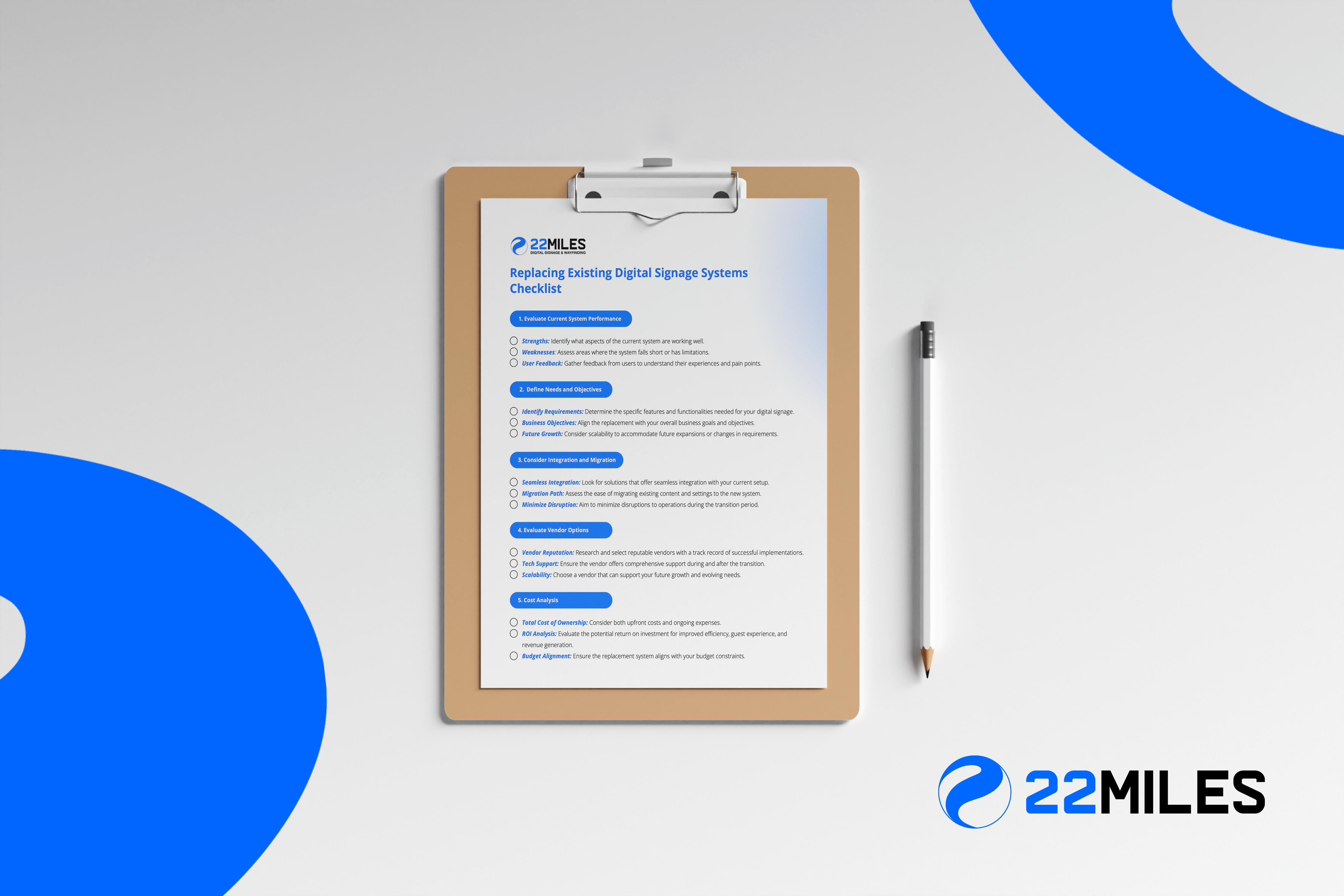August 25, 2025
If you’re considering replacing your current digital signage system, chances are you’re already familiar with its quirks, limitations, and frustrations. Maybe updates take longer than they should. Maybe your displays can’t integrate with the tools you now rely on. Or maybe your vendor’s support feels more like an afterthought than a partnership.
Upgrading your digital signage isn’t just about buying something new; it’s about making a strategic move that improves efficiency, engages your audience, and sets you up for future growth. With the right approach, you can minimize disruption, preserve what’s working, and unlock capabilities your old system could never deliver.
In this blog, we’ll explore the most common reasons organizations decide to replace their digital signage and how a well-planned transition can make all the difference. And when you’re ready to take the next step, you can download our Digital Signage Replacement Checklist, a step-by-step guide to make your upgrade smooth, cost-effective, and future-proof.
Why Organizations Replace Their Digital Signage
Switching digital signage systems can feel daunting. It’s easy to imagine the impending headaches: technical glitches, content migration hassles, staff retraining, and the inevitable “What if the new system isn’t any better?” That hesitation is understandable. After all, a poorly planned switch can cause more disruption than improvement.
But sticking with an outdated, underperforming system comes with its own hidden costs: wasted time, frustrated users, and missed opportunities to connect with your audience. The key is to approach the change with clarity. Knowing exactly why you’re replacing your current system and what you need from a new vendor will help you cut through the noise, avoid costly mistakes, and zero in on a solution that’s worth the investment.
Here are some key reasons organizations make the switch:
1. Performance Issues
Slow content updates, screen downtime, or lagging playback aren’t just frustrating; they can undermine the credibility of your communication. Older systems often struggle to keep up with modern demands for real-time content and high-resolution visuals.
2. Evolving Needs and a Lack of Scalability
What worked five years ago may not match your goals today. Growing organizations often outpace their digital signage systems’ capabilities. You may now need interactive touchscreens, wayfinding, mobile integration, or live data displays. If your current setup can’t handle these, it’s holding you back.
3. Clunky Content Management Flows
If publishing a simple update feels like a multi-step ordeal, or worse, requires IT intervention, you’re losing valuable time and agility. Bottlenecked approvals and fragmented workflows make it harder for teams to manage content efficiently and respond to urgent communication needs. Managing multiple displays across campuses, locations, or departments should be simple, not a logistical nightmare.
4. Poor Support and Vendor Limitations
Even the best hardware or software will fall short if it’s backed by poor support, slow updates, or a vendor that’s not innovating. If your provider can’t keep pace with technology or your needs, it’s time to look elsewhere.
How to Approach the Transition Strategically
The smoothest digital signage transitions don’t start with a product demo, they start with a plan. Before you ever speak to a vendor, take the time to understand exactly where your current system stands. Which features are valuable and worth keeping? Where are the bottlenecks, failures, or frustrations? Getting a complete picture of your system’s strengths and weaknesses will help you make informed, objective decisions later.
From there, define your success criteria. What will a “win” look like for your organization six months after implementation? Is it faster content updates, improved audience engagement, or better scalability across multiple locations? These benchmarks will not only help you evaluate vendors but also measure the true ROI of your new system.
Finally, follow a structured approach to guide every step of the process—from evaluation and vendor comparison to migration and onboarding. That’s exactly what our Digital Signage Replacement Checklist is designed to do: serve as your roadmap for a seamless, disruption-free upgrade.
Replacing Existing Digital Signage Systems Checklist
- Evaluate Current System Performance
- Strengths: Identify what aspects of the current system are working well.
- Weaknesses: Assess areas where the system falls short or has limitations.
- User Feedback: Gather feedback from users to understand their experiences and pain points.
- Define Needs and Objectives
- Identify Requirements: Determine the specific features and functionalities needed for your digital signage.
- Business Objectives: Align the replacement with your overall business goals and objectives.
- Future Growth: Consider scalability to accommodate future expansions or changes in requirements.
- Consider Integration and Migration
- Seamless Integration: Look for solutions that offer seamless integration with your current setup.
- Migration Path: Assess the ease of migrating existing content and settings to the new system.
- Minimize Disruption: Aim to minimize disruptions to operations during the transition period.
- Evaluate Vendor Options
- Vendor Reputation: Research and select reputable vendors with a track record of successful implementations.
- Tech Support: Ensure the vendor offers comprehensive support during and after the transition.
- Scalability: Choose a vendor that can support your future growth and evolving needs.
- Cost Analysis
- Total Cost of Ownership: Consider both upfront costs and ongoing expenses.
- ROI Analysis: Evaluate the potential return on investment for improved efficiency, guest experience, and revenue generation.
- Budget Alignment: Ensure the replacement system aligns with your budget constraints.
- Pilot Testing
- Trial Period: Request a trial or pilot testing to assess the performance of the new system in a real-world environment.
- User Feedback: Gather feedback from users during the pilot phase to identify any issues or areas for improvement.
- Performance Evaluation: Evaluate the performance and effectiveness of the new system against predefined criteria.
- Training and Onboarding
- User Training: Provide comprehensive training for staff to familiarize them with the new system.
- Onboarding Support: Ensure the vendor offers support and resources to facilitate a smooth transition.
- Documentation: Provide access to user manuals and documentation for reference.
- Implementation Plan
- Timeline: Develop a detailed timeline for the replacement process, including milestones and deadlines.
- Resource Allocation: Allocate necessary resources, including personnel and budget, for the implementation.
- Contingency Planning: Identify potential risks and develop contingency plans to mitigate them.
- Continuous Improvement
- Feedback Mechanism: Establish a feedback mechanism to collect ongoing input from users.
- Monitoring and Optimization: Regularly monitor the performance of the new system and make adjustments as needed.
- Stay Informed: Stay informed about emerging trends and advancements in digital signage technology for future upgrades.
- Maintenance Schedule: Develop a regular maintenance schedule to ensure all components function optimally.
Planning to switch digital signage providers?
A Successful Migration Story From a Leading Defense Firm
When Paul, an AV Architect for a leading defense company, set out to replace his outdated digital signage system, reliability and ease of updates were at the top of his list. His previous platform made even simple changes slow and stressful.
“The biggest challenge was reliability. For example, when the governor visited, we needed to display a welcome message on our 40-foot video wall. It took three attempts to get it to work, and it finally went live just as he was walking up the walkway. It shouldn’t have been that difficult.”
After evaluating multiple vendors at InfoComm, Paul chose 22Miles for its seamless wayfinding integration, flexible workflows, and ability to make instant updates without relying on outside programmers.
Paul’s switch to 22Miles worked because he identified the core issues with his old system: poor reliability, slow content updates, and a lack of flexibility, and made them the non-negotiables in his search for a new solution. By knowing exactly what he needed to improve, he could evaluate vendors with a clear checklist, ensuring the new platform truly solved his pain points rather than simply replacing one set of frustrations with another.
You can read the full story of Paul’s search and decision process here.
Your Next Step Toward Better Digital Signage
While switching digital signage providers may feel daunting, staying with a system that holds you back is even riskier. By identifying the gaps in your current solution, you’re already halfway to finding something better. Whether it’s unreliable performance, clunky content management, limited accessibility, or lack of integration, knowing exactly where your current setup falls short empowers you to make a confident, informed choice.
At 22Miles, we’ve built our platform to address the very challenges that cause organizations to switch in the first place. From intuitive, flexible content workflows to advanced accessibility features, seamless integrations, and unmatched reliability, we fill the gaps that others leave behind.
If you’re ready to stop settling and start thriving, use the checklist, pinpoint your priorities, and see how 22Miles can be the partner that delivers on them all. Book a demo to get started.




